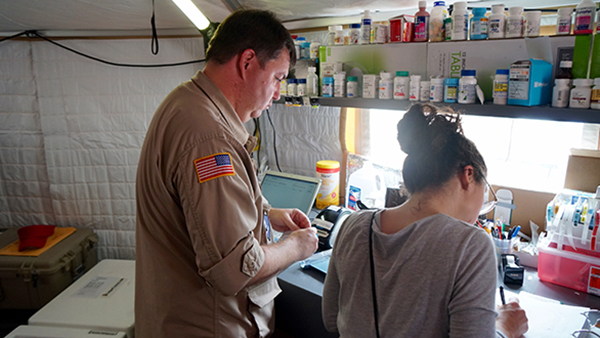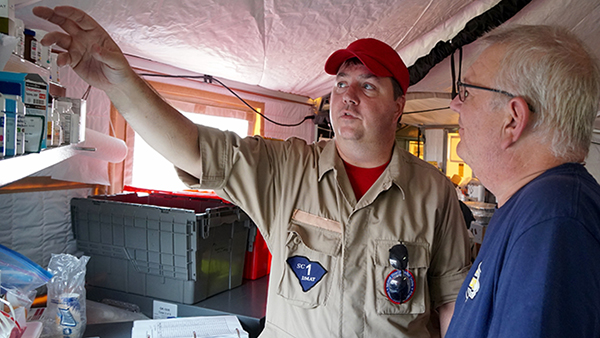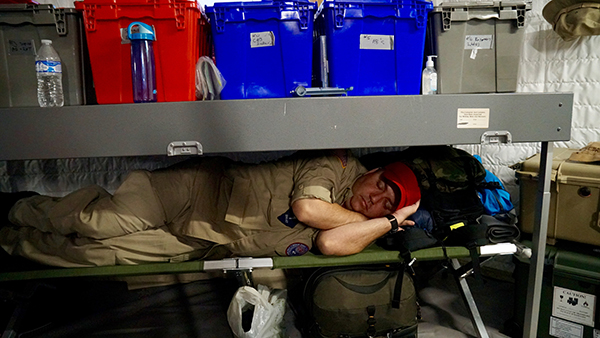When a Disaster Medical Assistance Team from South Carolina began seeing patients in Fajardo, Puerto Rico, it didn’t take long for the team members to realize that patients weren’t getting the lifesaving prescriptions they rely on to stay healthy every day or to fight infections in the wake of Hurricane Maria.

Pharmacist Russell Huiet saw a way to help those patients by reaching out to local pharmacies. He helped pharmacists better understand how a key federal assistance program works, where to find other open pharmacies, how to handle the surge of patients who need help, and how to work with suppliers to restore critical services.
Open for Business?
In many cases, people just didn’t know where to go to get their prescriptions. Their local pharmacy might be closed and many roads are still closed. Just finding an open pharmacy that had common prescriptions in stock remains a real challenge.
Huiet worked with his team to go out into the community and learn the basics. He went to different pharmacies in the area to see who was open, how long they thought they could stay open, what medications they had in stock, how they were getting resupplied, and how they were communicating their needs to corporate offices and suppliers.
Huiet also worked with local pharmacists to help them understand the scale of the surge in patients that they were about to see. Before the storm, a pharmacy might process 300 prescriptions a day. Now, those pharmacies might need to start processing as many as 2,000 daily prescriptions.

Emergency Prescription Assistance
Nearly half of the patients they were seeing didn’t have health insurance, but many of those patients were eligible to receive help under the Emergency Prescription Assistance Program (EPAP). EPAP was created to help people after a disaster who don’t have health insurance get the prescription medications, medical equipment, medical supplies and vaccinations they need.
Under EPAP, patients could register to receive a 30-day supply of their medications at no cost to them. People just had to register and then go to one of the over 750 participating pharmacies in Puerto Rico to get their medication or supplies. The patients were given a “cheat sheet” to help them navigate the registration process.
After patients applied, pharmacists could start filling prescriptions for life-saving medications, critical medical equipment and more – but the pharmacists weren’t familiar with the process. This is the first time that EPAP has been activated in Puerto Rico, and many pharmacists didn’t know how the program works.
Huiet created a “cheat sheet” for the pharmacists that explained the technical ins and outs of the system, helping pharmacists process requests more quickly and keep up with demand for medication.
Lights, Power and Refrigeration
As a pharmacist in South Carolina, Huiet knew exactly how pharmacies do business and he was able to provide pharmacies with information about disaster response they might not have.
He helped retail pharmacies work with suppliers to make sure they had power, refrigeration, communications, and enough life-saving medications the residents of Fajardo so desperately needed.
Helping Patients in the Days Ahead
Huiet and his team are working day and night in sweltering hot temperatures to help people in Puerto Rico get the care that they need. Huiet is hesitant to be too far from the action and he even found an innovative way to get a little sleep when he wasn’t on duty, setting up a makeshift cot just inches away from the pharmacy.

This is just one of many stories of responders from the National Disaster Medical System (NDMS) helping patients get the care that they need and supporting the health care system as it recovers from Hurricane Maria. NDMS responders are intermittent federal employees. In their everyday lives, they are the doctors, nurses, EMTs and other medical professionals and para-professionals that we rely on for routine care. But when disaster strikes, they may be called on to deliver the best of care in the worst of times.
NDMS can be called into action at the request of state, local, tribal or territorial authorities or by other federal departments. The Puerto Rican government called on them to support the response to Hurricanes Maria and Irma to support hospitals, provide patient care in communities, work with pharmacies, and much more.

There are many great ways for both medical and non-medical professionals to help communities in the wake of a disaster, but the best time to choose to serve is before a disaster strikes. Are you up for the challenge? Take a few minutes to learn how you can help the next time disaster strikes. To learn more, visit www.PHE.gov/Serve.

